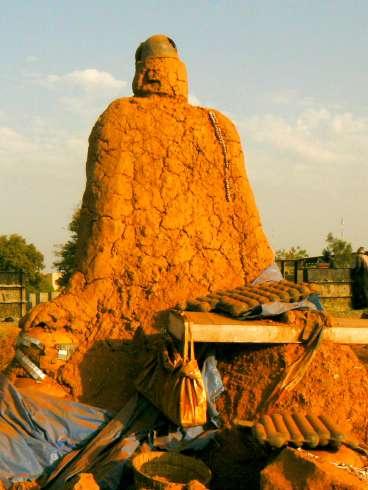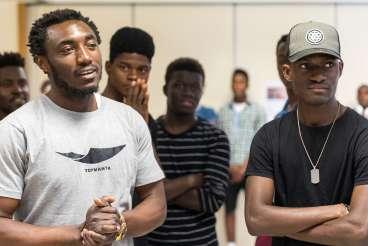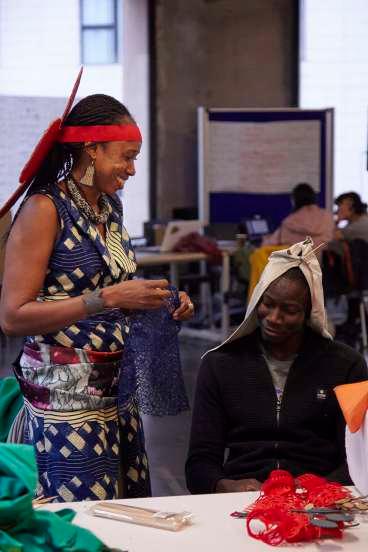
7 minute read
Grigri Pixel
Grigri Pixel WHAT IS IT?
2016-2020
Advertisement
G R I G R I P I X E L
A network of transformative urban initiatives and practices.
Grigri Pixel is a program of residences workshops and seminars that wants to explore the practices of cultural cooperation and citizenship between Africa and Europe, by manufacturing grigris or magical objects to protect and reenchant urban spaces through artistic practices and digital manufacturing, with collaborative and experimental nature from both continents. We understand the
magical as the practices that are still to be built, the collective processes that are difficult to measure and quantify, the learnings that arise in the limits of the unexpected and that are capable of changing ourselves by changing our closest environment.
WHY THE AFRICAN CONTINENT?
From this program, collective creation spaces are proposed to respond to the need for other stories and other ways of intervening in the city based on the
experience of invited initiatives from the African continent, often ignored, and that is only 14.4 km from ours.
This continent, immense, rich and diverse, has undergone an accelerated urbanization process, in which, simultaneously, the DIY and the culture of bricolage are the basis of many learnings and exchanges. This ability to compromise hybrid
forms between the public and the private, the formal and informal, the sacred
and the profane is a constant in historical and contemporary African social practices, producing innovative and suggestive ways to reinvent the urban.
CONNECT CITY CREATION EXPERIENCES
Grigri Pixel aims to connect and link these city creation experiences, between Europe and Africa in order to raise common questions capable of making visible synergies, meeting points or differences in re-enchantment practices and processes for a common life inside the city.
This initiative seeks to generate alliances with spaces, projects and local communities of the collaborating cities, with whom cooperating in the collective construction of grigris, protective objects that materialize and symbolize the creative potential of the collective in the city against the processes of homogenization and commodification of their common spaces.
Grigri Pixel thus seeks to weave a network of contemporary urban initia
tives and practices of a transformative nature that facilitates the exchange and learning of different knowledge and strategies in the creation of common urban
spaces for a diverse and multicultural citizenship.
GROS-GRIGRI IN BAMAKO. Built anonymously by residents of a neighborhood in the city to protect land against speculation.

JERRY DIT is a community that promotes the reuse of computer components to manufacture computers with plastic drums. 2016-2020
GRIGRI PIXEL
An interdisciplinary program for action research.
Grigri Pixel emerged in 2016 at the Medialab Prado (Madrid) contemporary cultural creation center on the initiative of Susana Moliner. Curator and cultural manager from Madrid, she has worked for years with artists and communities from different West African countries.
The design and activation of the workshop is carried out by David Pérez, an architect specialized in collective design processes; Yago Torroja, electronic engineer and professor at the Polytechnic University of Madrid and Blanca Callén independent researcher.
AN ITINERANT AND SITUATED PROGRAM
The program began with a first experience in February-March 2016 at Medialab Prado in Madrid, and continued with a second laboratory that took place in May of that same year in Dakar in the framework of the fifth edition of the Afropixel Festival organized by the Kër Thiossane independent art center.
In October 2017, the second edition of Grigri Pixel was held in Medialab Prado with a production workshop in collaboration with EVA Espacio Vecinal de Arganzuela, in addition to other activities in cultural spaces of the city.
Within the framework of this second edition, the initiative continued in November 2017 in Barcelona where a production workshop was held in collaboration with HANGAR and the Taula Eix Pere IV, both entities located in Poble Nou.
The third edition of Grigri Pixel, held from October 15 to 28, 2018 at Medialab Prado, revolved around the Right to the City. Objects that were designed, built and activated were part of a festive intervention as a Pilgrimage for the Right to the City in the Barrio de las Letras, in the Downtown District of the city.
In 2019 the fourth edition of this program is carried out, a proposal of actions that revolve around the theme of Hospitality. The program of activities is extended with respect to previous editions thanks to the collaboration with the NGO SERCADE and the Community Mediators Program of the Community Social Center Casino de la Reina. Together with them, we conducted a series of previous sessions, as well as a conversation between Marina Garcés and Felwine Sarr with the aim of outlining a reflection and action framework that will serve as the basis for the intensive workshop that will take place in October 2019.
Within the framework of this fourth edition, a production workshop has also been held in Niamey (Niger) in collaboration with the Arène Théâtre space.
2016-2020
G R I G R I P I X E L
Research associated with the project.
The Grigri Pixel laboratory aims to reconnect experiences of manufacturing objects and urban furniture with city building processes and common spaces.
This constructive and reconnection project is accompanied by a research
process that raises questions common to all these experiences in order to make visible synergies, meeting points or differences about the practices and processes of care and maintenance of urban spaces in Africa and Europe.
WHAT ARE THE QUESTIONS WE ASK OURSELVES
+ What are the spaces, goods, bodies or urban communities to protect by built grigris?

I EDITION. Manufacture of the see-saw during the workshop held in Dakar for the Afropixel Festival.
+ What are the threats and weaknesses that put at risk our communities and common urban spaces?
+ What conditions should a grigri have to take care of and protect the cohabitation of our cities?
+ Through the construction of these objects ... Can we create other narratives of our urban spaces? Is it possible to create these narratives from peripheral imaginary? Could these narratives be a way to reflect and project our multicultural cities?

+ Can the relationship with the magical and the invisible be an opportunity to recover other learning and subaltern knowledge?
+ What are the knowledge, tasks, tools, narratives, looks and peripheral and unconventional imaginary that could redefine and transform our cities - of origin or arrival - into spaces more careful, inclusive and livable?
II EDITION. Design of mobile, bright and self-sufficient benches for the Passatge Trullás.
IV EDITION. Previous sessions in SERCADE for the drafting of a Hospitality Manifesto.


III EDITION. Manufacture of clothing for the Pilgrimage for the Right to the City in Letters. 2016-2020
GRIGRI PIXEL
Thematic axes and research methodology.
All the research questions listed before are condensed and articulated from three general thematic axes:
A)
Spaces, goods, communities to protect or re-enchant.
Threats and weaknesses.
B)
C)
Local know-how, unconventional and peripheral.
Amulets. Strengths and opportunities.
Imaginary, looks and narratives (peripheral and decolonial)
of our cities (of origin and host).
HOW WORKSHOPS AND RESEARCH ARE COORDINATED
The research has a longitudinal character that unfolds from three moments:
1. Prior to the workshops:
A diagnosis is made to detect possible needs, know the local starting situation and thus help define some of the conditions and design parameters of the object to be built.
2. During the workshops:
The constructive and decision-making process of the design is observed and analyzed, through which the realities and local needs are materialized in the object but also the imaginary and shared ideas about the common spaces in which the project operates.
3. After the workshops:
An assessment is made of the workshop and its effects, of the possible (re) appropriations of the constructed objects and the consequences, in the short term, of the intervention carried out in that space.
Qualitative methodologies of ethnographic type will be used for the development of the research such as participant observation, individual or group in
terviews, photographic record, documentary analysis and other methodological
instruments that can be applied without the direct presence of the team but with complicity and help from the local community and that are able tocollect and produce data and information that are meaningful for the research objectives.






